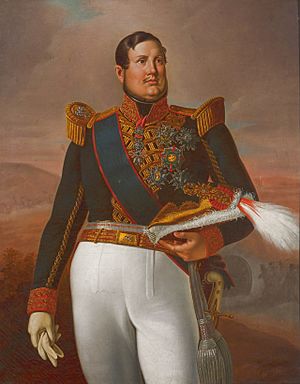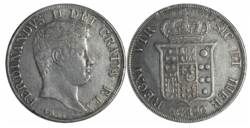Ferdinand II of the Two Sicilies facts for kids
Quick facts for kids Ferdinand II |
|||||
|---|---|---|---|---|---|

Ferdinand in 1859
|
|||||
| King of the Two Sicilies | |||||
| Reign | 8 November 1830 – 22 May 1859 | ||||
| Predecessor | Francis I | ||||
| Successor | Francis II | ||||
| Born | 12 January 1810 Palazzo dei Normanni, Palermo, Kingdom of Sicily |
||||
| Died | 22 May 1859 (aged 49) Caserta Palace, Caserta, Kingdom of the Two Sicilies |
||||
| Burial | Basilica of Santa Chiara, Naples | ||||
| Spouse |
|
||||
| Issue see details... |
|
||||
|
|||||
| House | Bourbon-Two Sicilies | ||||
| Father | Francis I of the Two Sicilies | ||||
| Mother | Maria Isabella of Spain | ||||
| Religion | Roman Catholic | ||||
Ferdinand II (born January 12, 1810 – died May 22, 1859) was the King of the Kingdom of the Two Sicilies from 1830 until his death. The Kingdom of the Two Sicilies was a large country in Southern Italy. It included the island of Sicily and the southern part of the Italian mainland.
Contents
Family and Early Life
Ferdinand was born in Palermo, a city in Sicily. His father was King Francis I of the Two Sicilies. His mother was Maria Isabella of Spain.
Ferdinand had many royal relatives. His grandparents were King Ferdinand I of the Two Sicilies and Queen Maria Carolina of Austria. His other grandparents were Charles IV of Spain and Maria Luisa of Parma. Interestingly, Ferdinand I and Charles IV were brothers. This means Ferdinand II's parents were cousins. One of his sisters, Teresa Cristina, became the Empress of Brazil. She was married to Pedro II, the last emperor of Brazil.
Becoming King and Early Actions
When Ferdinand became king in 1830, he was quite popular. Many people believed he had modern ideas. His friendly manner also made him well-liked by the common people in Naples.
He promised to be fair in his rule. He also said he would improve the country's money system. He wanted to help the kingdom recover from past problems. His main goal was to make his people happy. He also promised to respect other rulers and the Roman Catholic Church.
The first years of his reign were peaceful. He lowered taxes and reduced government spending. He also brought new technologies to his kingdom. He built the first railway in Italy. This railway connected Naples to the royal palace at Portici. His navy also got the first steamship in Italy. He set up telegraph lines between Naples and Palermo.
However, Ferdinand was also very strict. In 1837, he used force to stop people in Sicily who wanted a constitution. A constitution is a set of rules for how a country is governed. He kept a close watch on everyone in his kingdom. Many people wanted him to give them more freedom.
The Revolutions of 1848
In September 1847, there were violent protests in Reggio Calabria and Messina. These protests were led by people who wanted more freedom. Ferdinand's army quickly stopped them.
On January 12, 1848, a big uprising began in Palermo, Sicily. This event helped start many other revolutions across Europe that year. Similar protests happened in Salerno and Cilento. Many educated people in the kingdom supported these changes.
Because of these widespread protests, King Ferdinand had to agree to a constitution. This constitution was similar to one used in France. However, there was a disagreement about what the members of parliament should promise. The King refused to change his mind.
Riots continued in the streets. So, Ferdinand ordered his army to stop them. He also closed the national parliament in March 1849. Even though the constitution was never officially canceled, Ferdinand went back to ruling as an absolute monarch. This means he had all the power.
During this time, Ferdinand helped Pope Pius IX. The Pope had to leave Rome because of similar protests there. Ferdinand gave him a safe place to stay in Gaeta.
Meanwhile, Sicily declared itself independent. A leader named Ruggero Settimo said the King was no longer in charge. Ferdinand sent an army of 20,000 soldiers to Sicily. Their job was to take back control. The navy also attacked the city of Messina. They shelled the city for eight hours, even after its defenders gave up. Many people died. This earned Ferdinand the cruel nickname re bomba, which means "King Bomb."
After about nine months, Sicily was fully under Ferdinand's control again.
Later Years and Death
Between 1848 and 1851, many people who disagreed with King Ferdinand had to leave the country. About 2,000 people suspected of being revolutionaries were put in jail.
In 1850, a British politician named William Ewart Gladstone visited Naples. He wrote letters to the British Parliament. He described the "awful conditions" in the Kingdom of the Two Sicilies. He said it was like "the negation of God erected into a system of government." These letters made people across Europe concerned. They made the kingdom seem isolated from other countries. This isolation later played a part in the kingdom being taken over by the Kingdom of Sardinia. This event led to the creation of modern Italy.
The British government had been an ally of Ferdinand's family. But they also had business interests in Sicily, especially in sulphur. Ferdinand tried to limit British influence, which caused problems. Because Ferdinand ignored advice from Britain and France, these countries removed their ambassadors in 1856.
In 1856, a soldier tried to kill Ferdinand. Many people believe the injury he got from the soldier's bayonet led to his death. He died on May 22, 1859. This was shortly after France and the Kingdom of Sardinia declared war on Austria. This war later led to Giuseppe Garibaldi invading Ferdinand's kingdom. This invasion was a key part of Italian unification in 1861.
See also
 In Spanish: Fernando II de las Dos Sicilias para niños
In Spanish: Fernando II de las Dos Sicilias para niños
- Naples–Portici railway line



